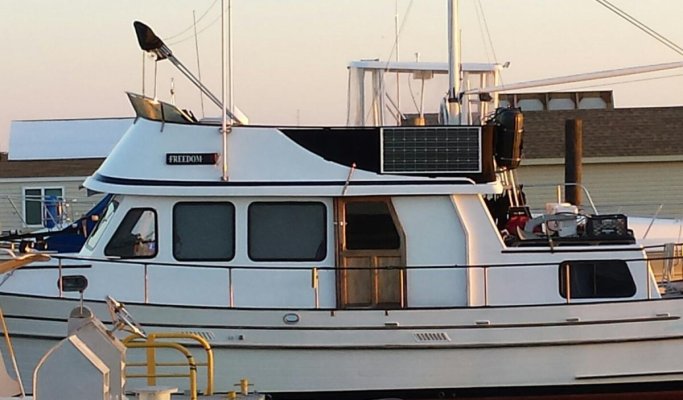Hello Swampgatr.
I now have a total of 445 watts in five panels atop Seaweed. It matters not if I am plugged into a shore power or at anchor. My life is the same.
EXCEPT I cannot run the wall-banger air-conditioner while at anchor.
One thing to remember is it is not just power generation you need to deal with. You also must have a place to store the power derived from solar, wind, etc. So as you are thinking about what you require, also factor in batteries.
Aboard Seaweed I have 700+ amp hours in seven batts.
I get about 150 amps per day from my solar panels.
Additionally I have a wind generator that helps bump things up too when the wind blows.
Note: It is never windy enough when you are like me and anchor close to shore and in the lee of islands.
A Kill-O-Watt meter will tell you how much power your items use. In 80 degree ambient temperature my reefer/freezer combination (the smallest made, 3.1 cubic feet by Haier) uses 60 amp hours in a 24 hour period.
That leaves me a theoretical 90 amps for everything else.
Definition of "everything else"
Computer (netbook, uses 15 watts per hour maximum)
DVD player (15" runs on 12 volts and uses 24 watts maximum)
Microwave (700 watt model by Rival uses 10 amps a day)
The depth sounder is on 24/7. It uses 6 amps in 24 hours
VHF radio is on 24/7. I'm not sure how much it uses (I forgot)
I've got a couple of fans that run when needed
Inverter uses .6 amps per hour when running (it cycles)
My batts stay topped out when the sun shines.
Having real estate for solar is important. Having an expensive MPPT solar controller will increase the power your solar puts into the batteries. The less expensive controllers work too.
IF you have limited real estate for solar I would opt for the higher dollar/better performing MPPT controllers. And yes, I'm about as thrifty as it comes. On some things the better item is the best choice, even if it is more costly up front.
Good luck.
There are a lot of us out here with solar.
Mini Lesson: Solar charges batteries through a solar controller.
Batteries supply power to inverter.
Inverter changes battery power (12 volts) into AC (120 volt) power like you'd have in a house.
All three components have to work together.
Start small. Solar to batteries to 12 volt items. THEN move up and start with your AC side of the boat.
If you're like me you will find that buying a cheap throw-away refrigerator for $150 is better economically than spending $700 or more on a small 12-volt one. When mine quits I'll go to Walmart and buy another.
Years ago (pulling on old-fogey slippers) "everyone" switched over to 12-volt items. It was the "newest and greatest" thing. We stopped using iceboxes (with blocks of ice) and life was good. Then, well, things change.
The DC refrigerators (reference Engel for instance) are wonderful. They are also WAYYYY beyond my budget. By increasing gradually the amount of solar I have, I'm now able to buy and use any item off the shelf from regular stores such as Walmart.
I do not need to buy expensive "Marine" items.
Anyway I do wish you all the best swampgatr. Good luck.
P.S. - I am NOT a power expert. I'm relating the experience I have had while out here for the past 8 years. There are some real technical folks here that are far more numbers oriented. I just want it to work, you know?


